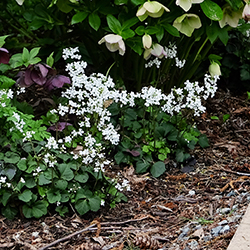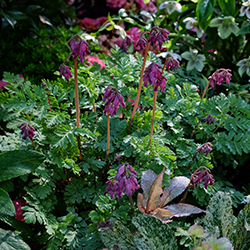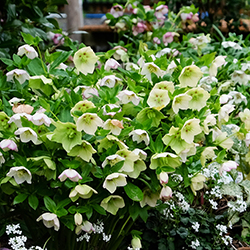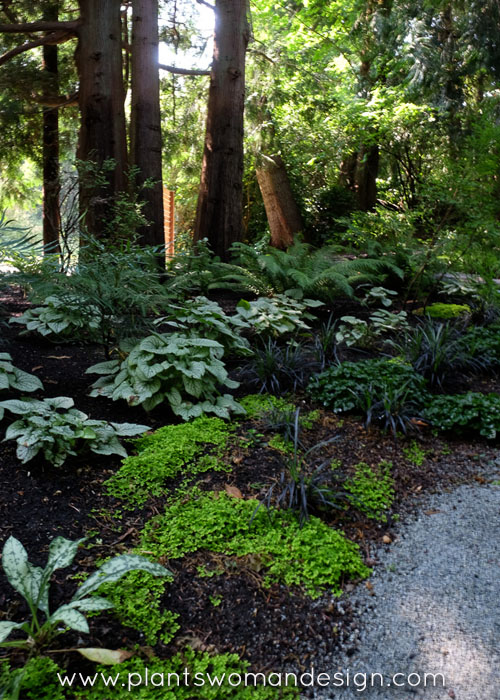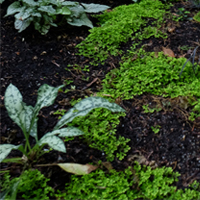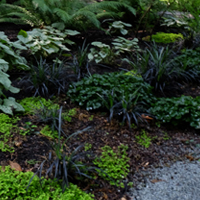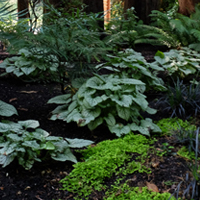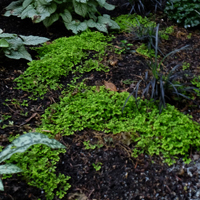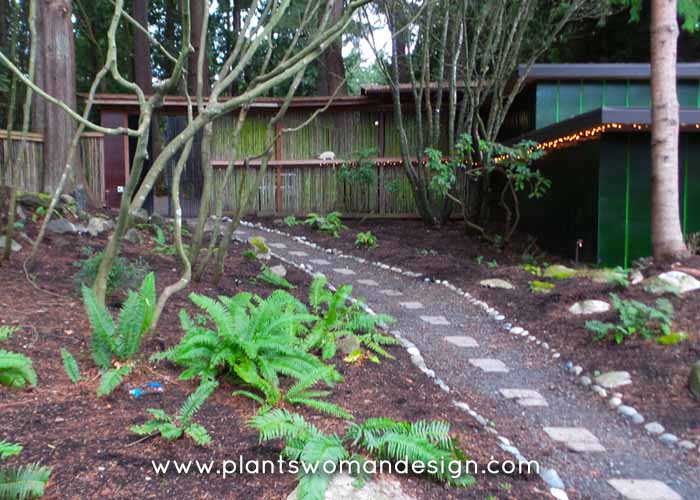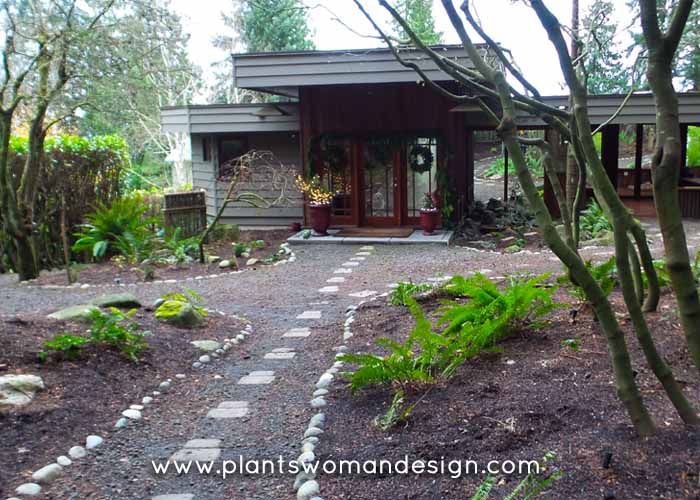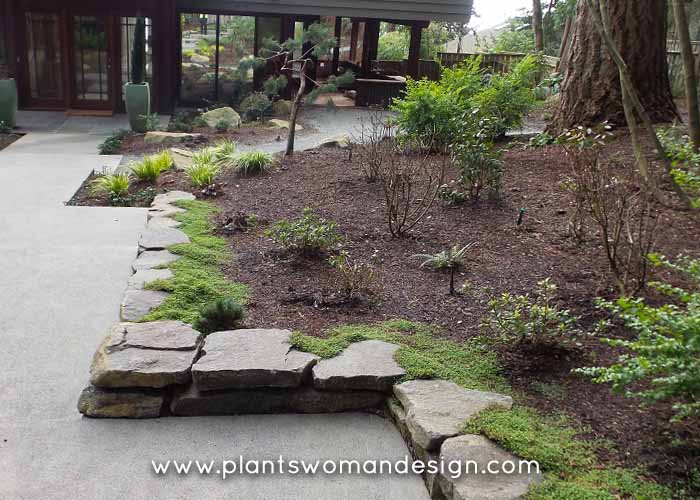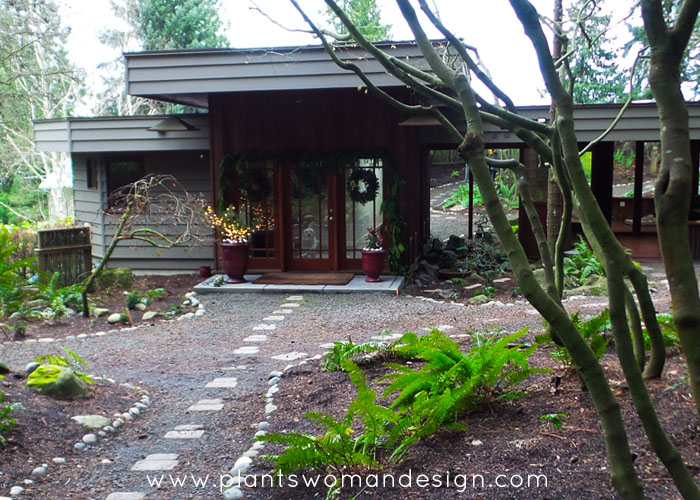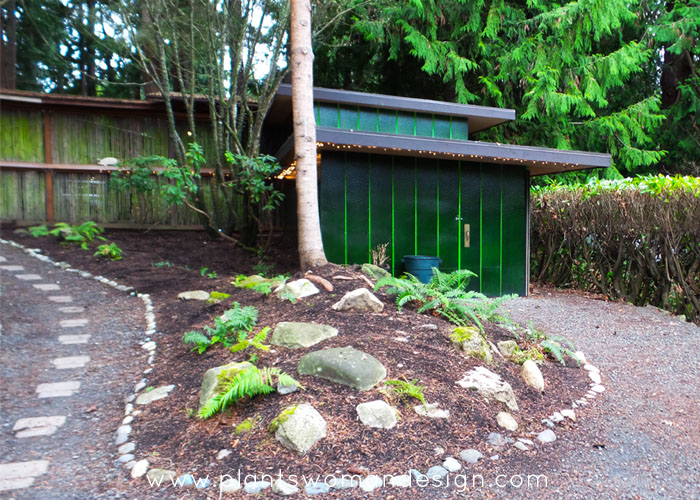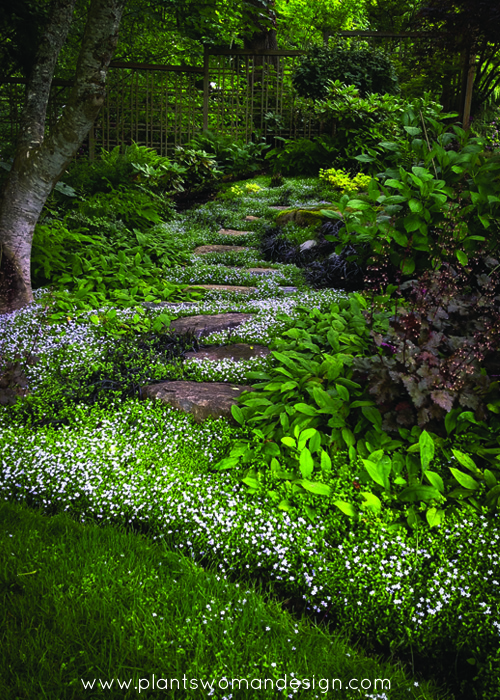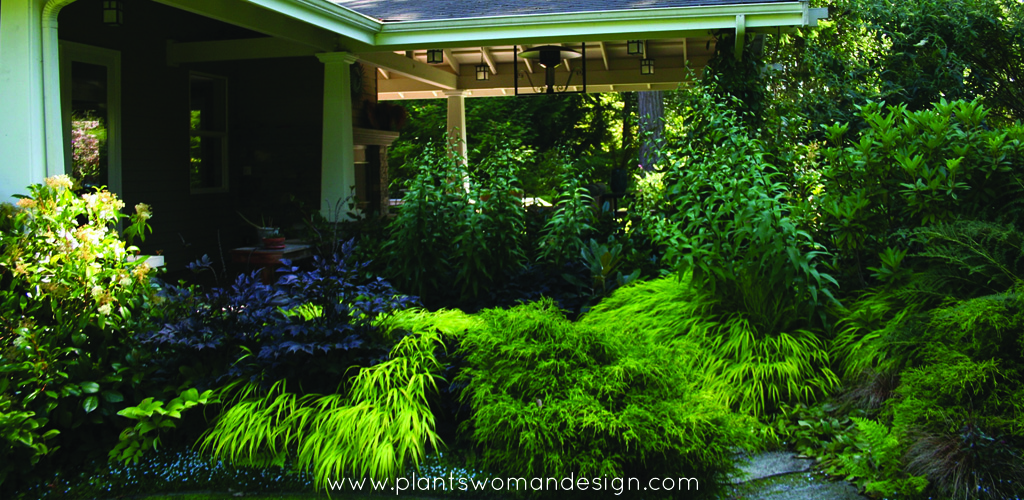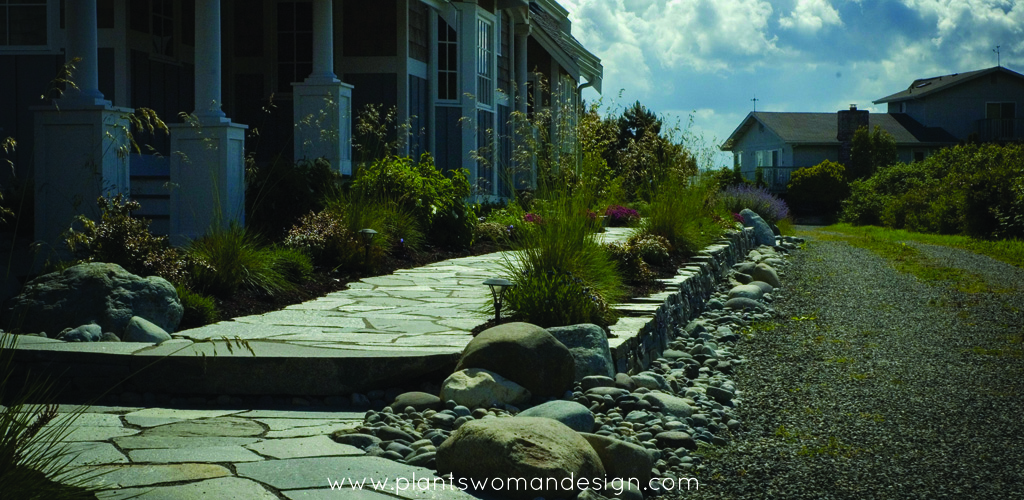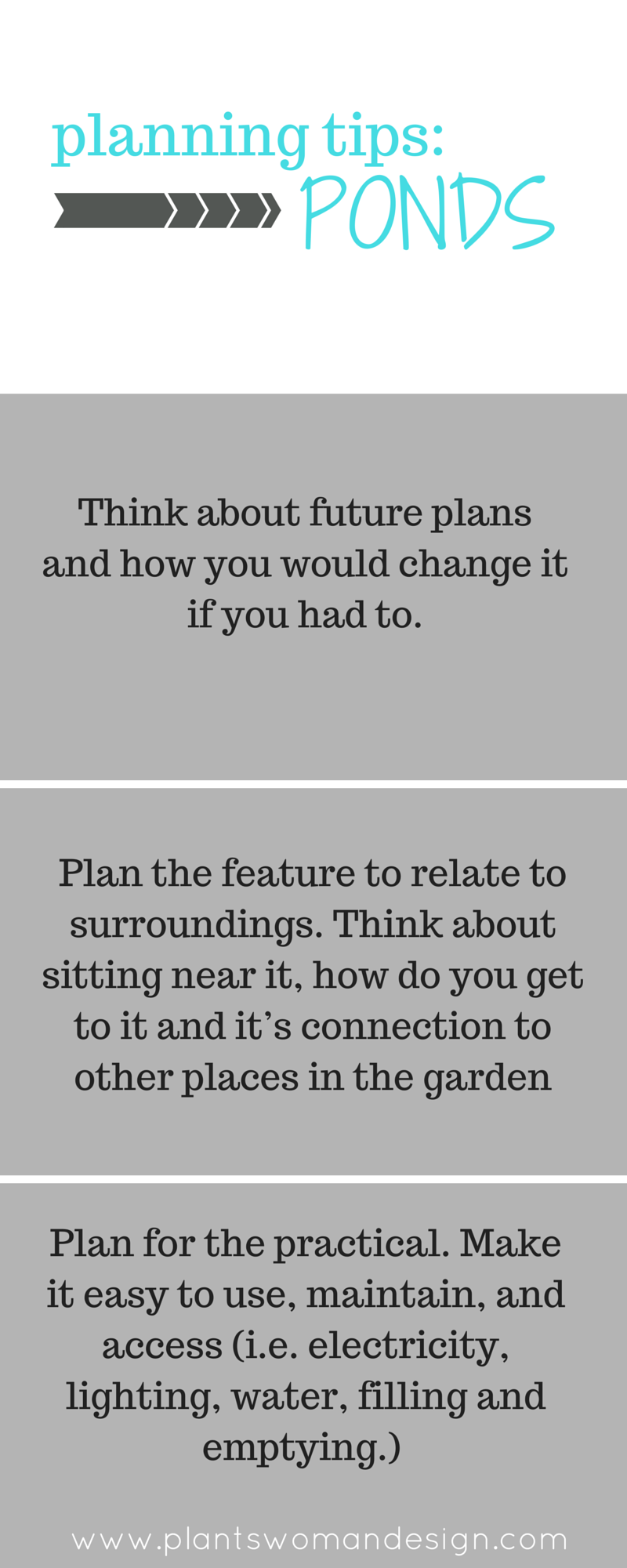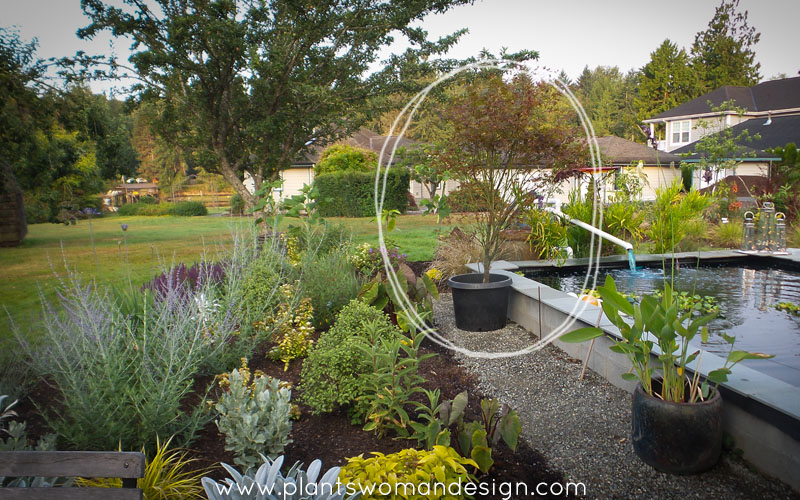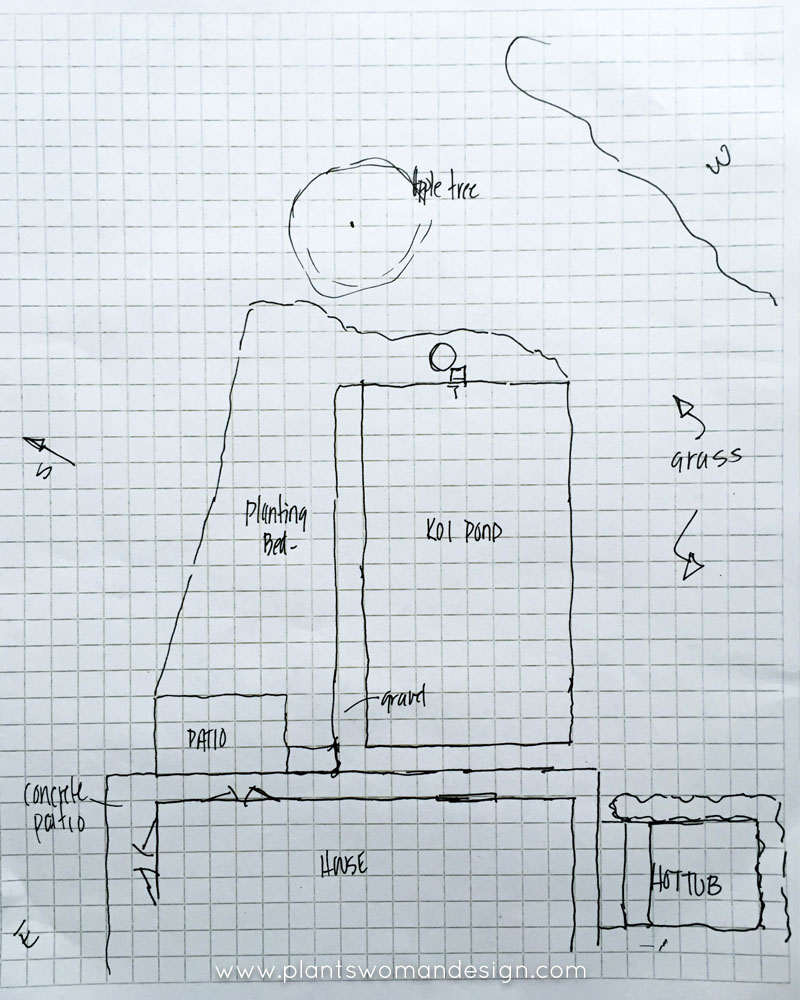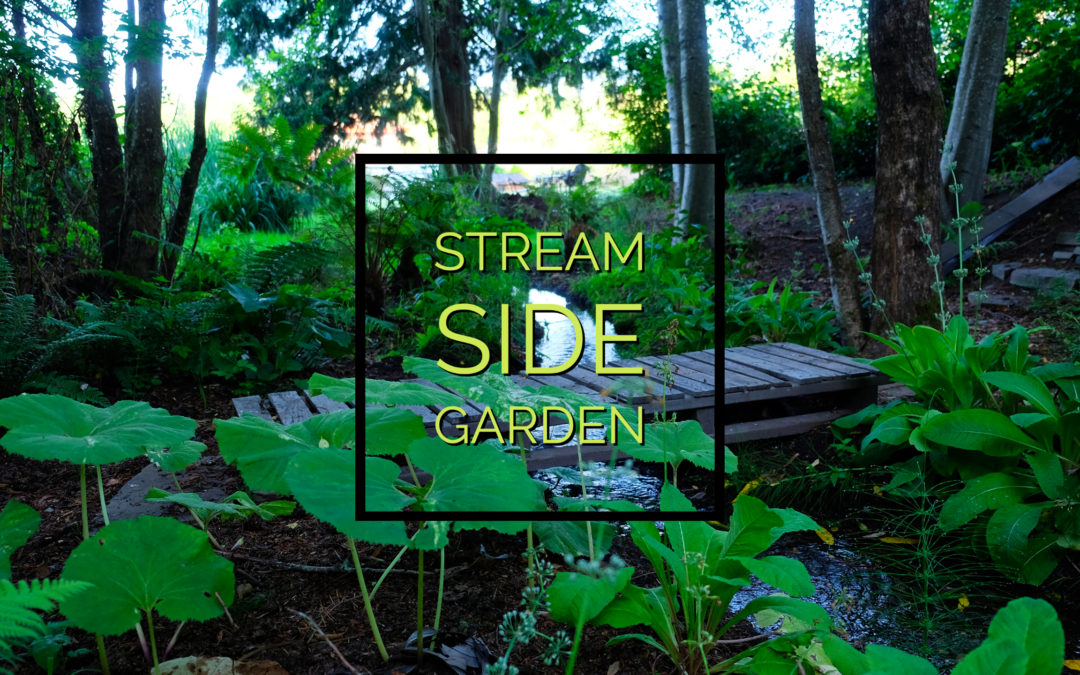
by Susan | Sep 12, 2020 | gardening, LB Tutorial: Design Challenge, Plantswoman Design
Often a bad situation brings about an opportunity to create something new. In this case, a property line definition blocked off access between two sections of my garden. The wildflower garden and the shade garden have a stream between them with lots of brushy weedy plants that I hadn’t really attended to yet. To take full advantage of this opportunity I created a new path and a bridge made of an old pallet, then brought in all the plants. The boggy ground is perfect for ligularia, primrose, rodgersia, gunnera, Salix, red twig dogwood, and ferns. A couple of trees in the center of it all hold the platform of a treehouse for visiting kids. Taking adversity and turning it around is a principle we should all practice more.
stream side garden
Jack in the pulpit
plants
stream side garden
ALL
the
Ferns
plants
stream side garden
Prim-ula
plants
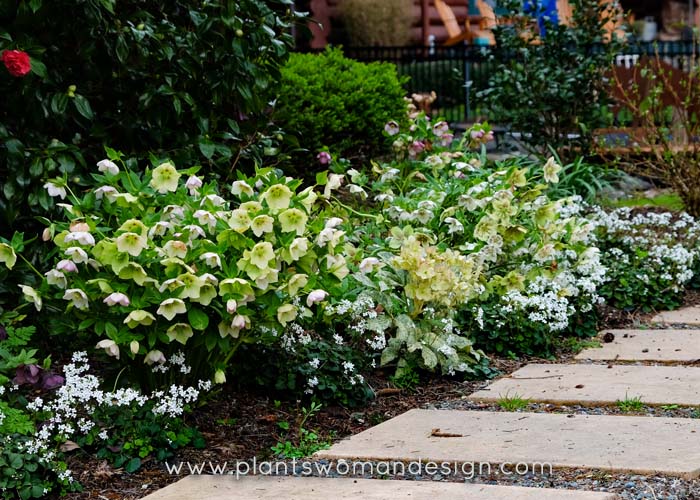
by Susan | May 13, 2019 | LB Tutorial: Design Challenge
Spring borders are always a little challenging. Some plants are stubborn and refuse to bloom at the same time every year. Other plants are just emerging and are not partial to competition (I took out Galium Oderatum for that very reason). Planning the spring border is one of the most important things to plan. You want to be sure to plant things that are amazing in the spring but not leave a big blank space for the rest of the year. We have all seen a huge swath of spring bulbs in a garden that looks great for a couple of weeks but then becomes dying foliage, then blank space. If you go to the nursery in the spring you will only find things that are blooming at that time. The sales factor in the nursery is bloom. With planning, you can buy things that are either not in bloom or will be in the nursery later in the year. The border should have interest into the summer and autumn. Evergreen pieces will provide a totally different look in the winter when the perennials are dormant and deciduous shrubs are bare.
I enjoy plants that are bright and stand out in our gray days. This one has bright red/pink in the background that gradually turns purple as the season progresses. Remember that variegated foliage can add to the color combination as well as blooms.
If you have an area you want to renovate and create a more cohesive design, start by removing plants that won’t fit into the plan. Be ruthless and move the ones you love to other areas of the garden, and get rid of ones that no longer appeal, or are invasive. Starting from scratch is really a fun project. Divide the area into layers and plan to have larger plants in the back as a background if it is an edge bed. If it is an island bed the larger plants go in the middle and graduate levels of plants down. I plan the bed to be amazing in the spring and more muted later in the year. If you only put ½ of the plants as spring plants then the rest of the plants that bloom at different times it is more of a mixed border, not a spring border.
Hellebore ‘Pacific Frost’
The front of the border is one of my favorite ground covers Cardamine trifolia. It is evergreen with three leaves held above the ground. The sweet white flowers come up above the foliage in a rush of bloom early in the year. It continues to bloom over the remainder of the summer and fall. This slow spreader it is slug proof (A huge plus in my garden) and easy to care for.
The Galanthus are finished blooming and only the green/blue strappy foliage is left. A white epimedium is throwing airy white blooms and purple new foliage to cover the dying foliage of the Galanthus. Mixing a couple of different types of hellebores add to the drama of white both in bloom and in foliage. The hellebores are a great variegated leaf ‘Pacific Frost’ the green and white look great even later in the year after the flowering has stopped. A double white hellebore ‘Florence Picotee’ is at the back and single white hellebore (probably a mardi-gras mix) in the center, and behind is an amazing green one called ‘Jade Star’. Many of my hellebores are from Northwest Garden Nursery in Eugene Oregon, for many years a producer of fabulous cultivars of Helleborus.
As this planting evolves in later spring the purple/red starts coming on. The bleeding heart (dicentra bacchanal) with dark purple-red blooms, the new foliage on the ‘Pacific Frost’ hellebore is blushed with purple, and the new leaves of the epimedium also are a muted purple.
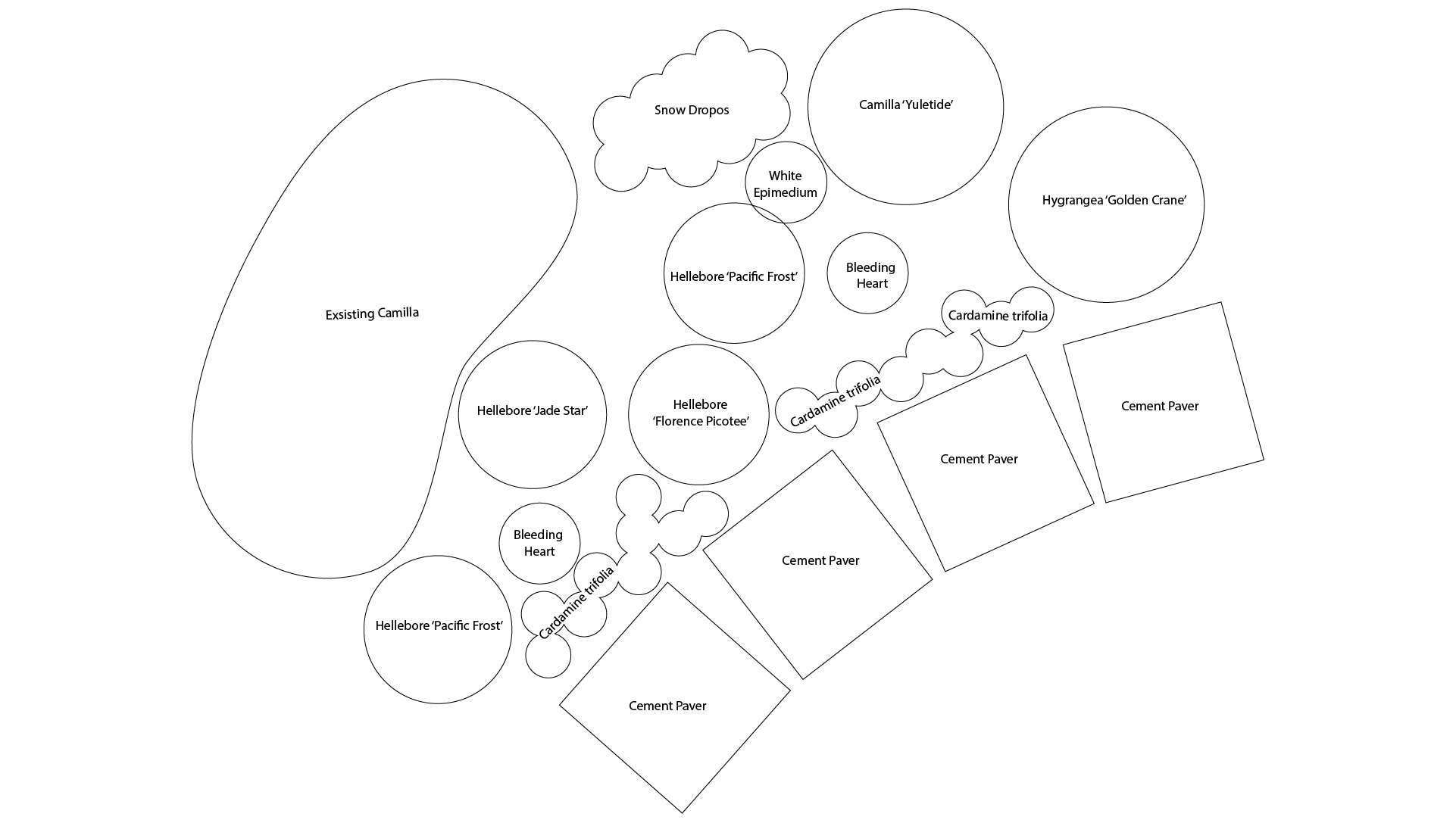
In this border, the background is a large red/pink camellia in the garden when I purchased the house blooming a little ahead of time. There is also a Hydrangea ‘Golden Crane’ that will bloom later in the year in the background. A camellia ‘yuletide’ is finished blooming near the ‘Golden Crane’. The camellias serve as background for the rest of the bed. As spring turns into summer the greens take over, the variegated leaves are beautiful and the cardamine and hydrangea bloom. A muted palette in the summer and fall but still full and lush.
So pick your color combinations then start at the bottom layer with ground cover that is in the main color, right placement (Sun or shade), and same bloom time as the rest of the bed will bloom. The second layer is next with accent color at about 50%, and the rest in the main color with the same bloom time and placement. The final top layer would be more of the main color and accent color at about 20%. Remember to try some fun textures (grassy, glossy leaf, variegated) mixed in and think about what it will look like in 3 months, and 6 months. Early summer and late summer plants can be added to continue the bloom (lightly) but it is important to remember that a full spring border cannot be a full summer and full fall border. Other beds can be planted in other areas of the garden that will bloom at different times.
Hope that this is helpful. If you have questions email me and I can possibly help.
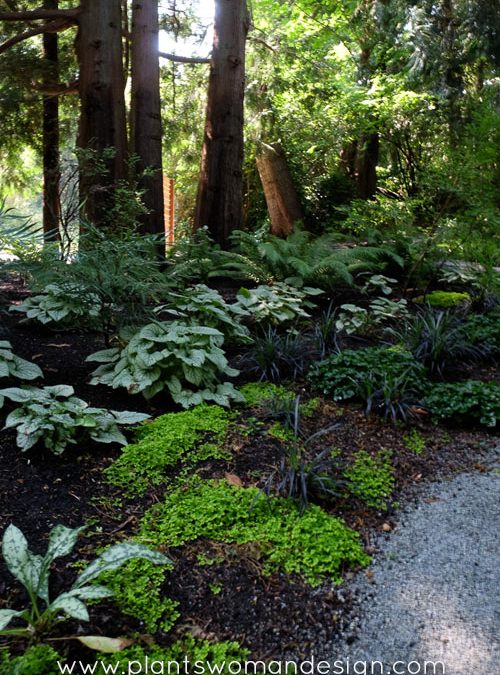
by Susan | Aug 24, 2018 | LB Tutorial: Design Challenge, LB Tutorial: Skills, plants
Shady Characters: Planting for Shade
Tall fir and cedar trees tower over this garden bed which can create a tough place for plants to live. The roots of the trees and their greed for water will make many plants give up and die. However, these plants, with supplemental irrigation, can not only hold their own but thrive.
Pulmonaria ‘Diane Clare’ Lungwort
The leaves of the PUlmonaria ‘Diane Clare’ Lungwort have both spotty variegation and solid white leaves. The blue flowers, which turn to lilac with age, bloom in May and June. The long graceful leaves lends a different texture to the combination. Zone 3, can take dry shade or moist soil.
Ophiopogon planiscapus nigerscens – Black Mondo grass
Once a rarity Black Mondo Grass is now becoming more readily available. Many times it is used in a sunny situation where the black leaves become scorched and sad looking. Here in the shade mixed with low growing Golden Spike Moss it is amazing. Not fussy about water and great next to a path it is able to spread to its hearts content. Zone 6, prefers moist soil, blooms in July-August, evergreen (or ever black).
Brunnera ‘Jack Frost’
Variegated spiderweb patterned leaves and floating blue flowers light up this area despite gray weather. Filtered sunlight and access to an adequate amount of water is all they need. Irrigation in this area helps to maintain their lushness and the shallow roots don’t have to compete with the deeper roots of the trees. ZONE: 5, likes moisture, blooms in April and May.
Selaginella krassiana ‘Aurea’ – Golden Spike Moss
This sweet little creepy thing really creates a matte of contrast to the black mondo grass. It disappears a little bit in the winter but comes back lushly in the spring. Zone 7, prefers moisture, part shade to shade, evergreen to semi evergreen.
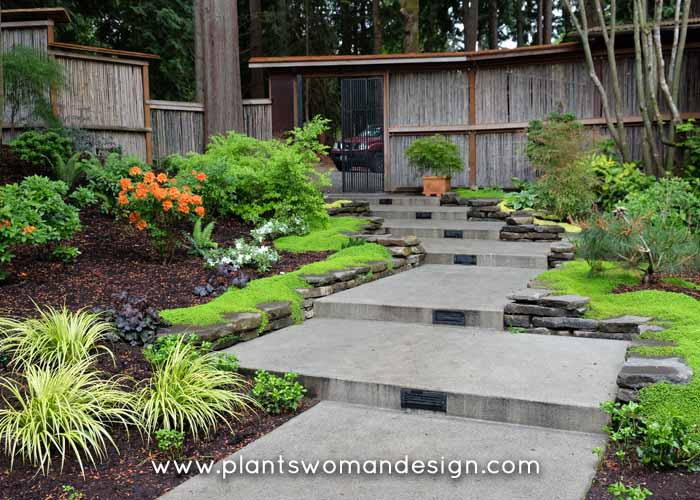
by Susan | Jan 20, 2018 | LB Tutorial: Design Challenge
During the winter months pathways become more important. Just a way to get to a destination? No, but a way to keep out of the wet, above the often muddy, leaf covered beds and soggy grass. Often in the summer pathway edges are obscured by overhanging plants and seem to disappear. But during the winter they need to be easy to navigate, open and beautiful.
Paths can also be a dominate design consideration. This mid-century house is amazing and deserving of an amazing entrance. The gravel and rock edged path was not at all appealing. Creating an entrance with rectangular slabs of concrete that was in keeping with the rest of the angles on the house was exactly right. The slabs are paced out with an offset, so the walker is able to walk and enjoy the journey through the updated garden without worrying about where to put their feet. The entry gate is offset from the entry to the house to provide the sense of expectation. The house can be seen from an angle becoming more visible as you walk down the path. Lights are placed in the rise of the steps to provide good visibility during the dark. The canopy of high fir trees makes it shady during the day and especially dark at night.
Stone was added to edges to retain the soil and keep it from the pathway. Choosing a complementary stone and keeping the angles flat and squared up helps transition the concrete into the natural.
Updating the garden meant having to let go of some of the smaller Vine Maple trees (Acer circinatum). They grew in a thicket and needed to be thinned out. The remaining trees were limbed to accent the beautiful curves in the trunks. Planting pockets were found under the larger trees to add rhododendrons, sarcococca, and azaleas. The open ground around the pathway was filled in with Acorus, Low mosses, Heuchera, pachysandra, and fern. Specimen pines and Japanese maples that the owner had collected were replanted at intervals along the path. We had originally chosen Japanese forest grass to edge the path but the two dogs who live here grazed it like cows. The acorus was not nearly so tasty apparently and adds bright color and movement to the beds. The pallet of bright green, orange and purple lightens up the area during the daylight hours.
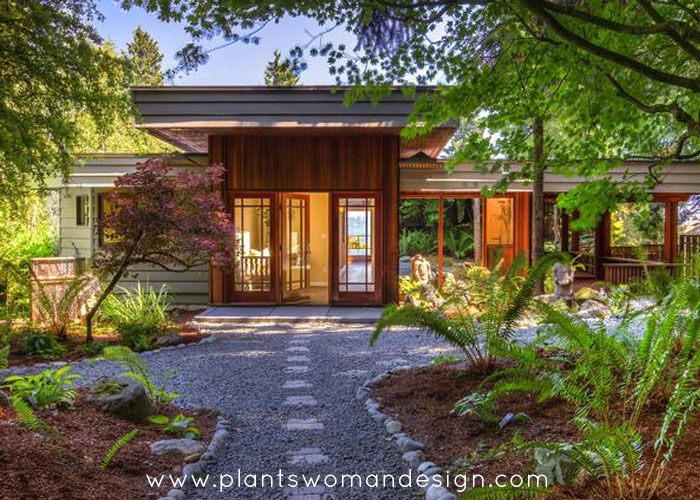
by Susan | Jun 10, 2016 | LB Tutorial: Design Challenge
A beautiful house with history and modern lines, a stand of old mature fir trees, and wonderful clients, what more could a designer ask for?
This lovely home was remodeled and updated about 6 years ago. Built many years ago without permits it was a definite challenge. A sensitive contractor and clients with good design esthetics made for a gracious custom home. After the remodel the garden was kept clean and tidy but did not really have the same level of design and materials as the house did.
I was excited to be involved. Some of the challenges of the site were the same as in the house. How to keep the eclectic history of the garden with large trees and native plants while creating an entry walk worthy of the house. A bamboo fence added a little of an Asian feel, leaving it was important because of the history but we didn’t want the garden to be a Japanese style garden. I minimized it with a much more dominate walkway and plantings that draw the focus down to the entry of the house.
Thinning out the Acer circinatum, native Vine Maple, was a hard sell for my clients. Getting to see the thin lines of trunks with their twists and beautiful bark, uncluttered the mid level of the garden was an important element. It becomes a lighter space, and you are able to view the entry while walking through the tall dark fir trees, and lovely light green trunks and leaves of the maples.
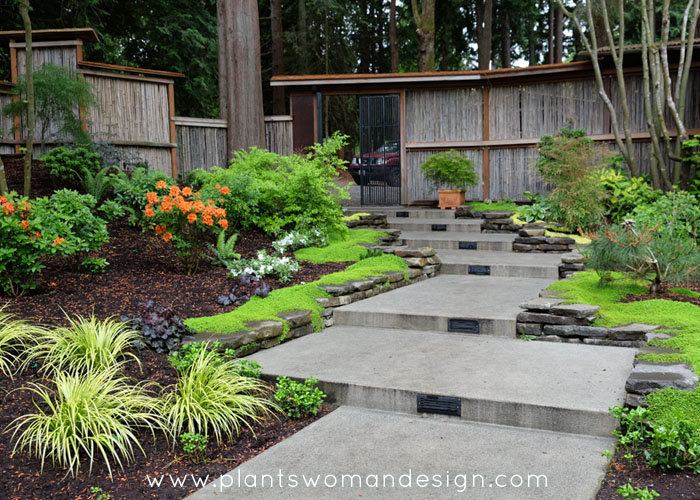
The walkway was created out of poured concrete that was acid washed. Subtle down lighting illuminated the area to walk on without giving too much light that would distract from the garden itself. By creating an indirect path it gives an opportunity to pause on the way down to the front door. Sometimes walkways that go down to an entry are more difficult to feel at ease on. The front cement stoop was removed and stone tiles that match the inside hallway stone were added. This creates a visual that draws the eye from the front porch through the entire house to the view out the front windows. A sense of arrival that is a real reward for walking down the pathway.
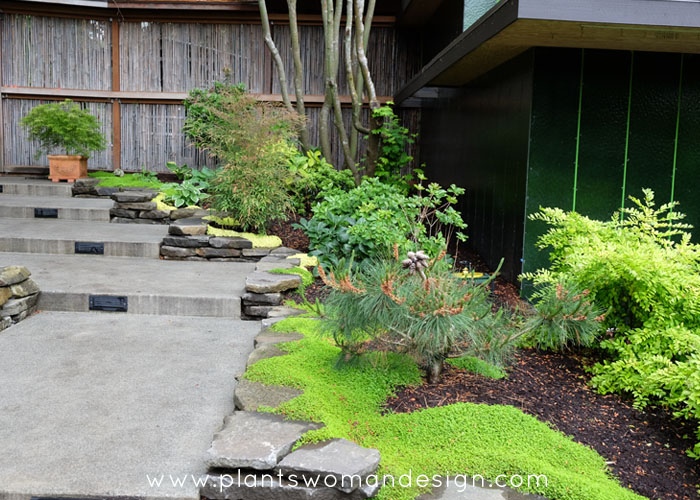

Stone on the edges of the walkway (Silver Falls Ledgestone) keep the walkway clean from higher soil levels along the path. These are also softened with a combination of two types of Baby Tears. Bright green plant foliage also lightens up the area. Japanese maples and mugo pines were on the property along with some additions from the client’s other home. Many of them were moved into new positions that made them more important. Focal points were created in different areas, with dog proof groundcovers on the edges of the pathways. A fine gravel, granite ¼ inch minus, (also called decomposed granite) gives a solid pathway that is still friendly to dog paws.
Guests are always excited to come and visit and while sorry to leave, the walkway gives a beautiful, totally different perspective on the way out.
Work with what you can keep on a site. You don’t always have to take everything out and start over. Leaving some of the plants on a site give a sense of history to a garden.
Design for all the users of the garden. The first bright green grass I used (hakonechloa macra aureola) had to be replaced because the clients two dogs loved it so much they ate it. The acorus graminus, sweet flag grass, is just as lovely without the same attraction for the dogs.
Create interesting perspectives from different areas of the garden. Coming in should be different than leaving and cameos of special plants can be scattered around the garden.
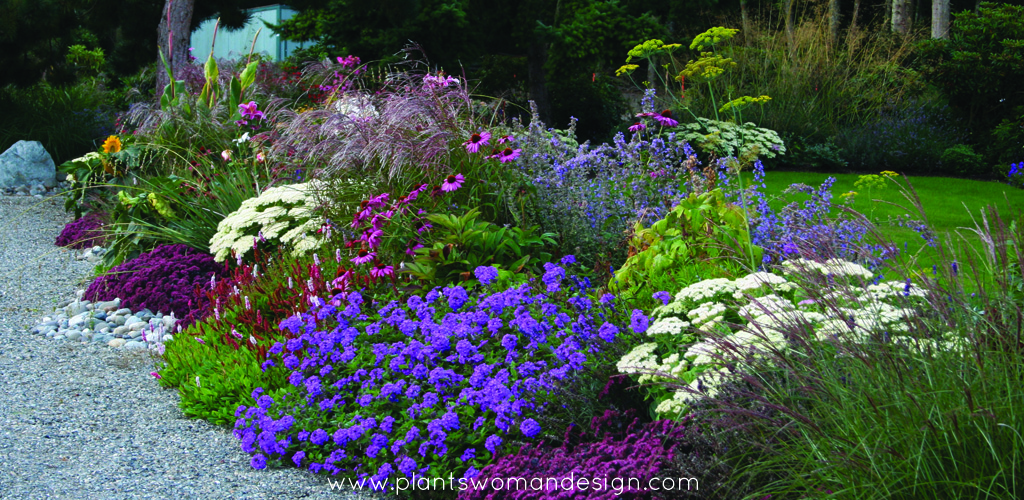
by Susan | Oct 18, 2015 | LB Tutorial: Design Challenge
Designing a garden can be tricky and every project is different. There is simply no cookie cutter approach to garden design. Each client comes with different needs, tastes, and property. What to know a secret? One of the hardest things to design is a blank slate. No kidding, it really is difficult. Having pre-existing features to work around often steers the design. For example, if the house is already built you can’t really move it to optimize the sun. Or, if there is a big slope with a drain field in it you can’t really change it.
Often I get to be in on the beginning of a project, before the house is even sited. While it is energizing and fun it is challenging as well. One of the hardest things to get right is scale because the scale garden should match the scale of the house. If the lot is covered with trees they affect the way the house is positioned, and often some must be removed to optimize sun. Here in the Pacific Northwest we always want more sun. Gray days tend to make homes dark so windows that face south are important. Tree planting, including height considerations, is very important. Shade on the west side is good and filtered sun on the east is also good.
Here are a couple of things to think about as you plan your garden.
- Bones of a garden are structural features. These can include trees (both existing and planted), outbuildings like sheds, gazebos, and chicken coops, and gathering places like patios, fire pits, and sport/play areas. Planning these areas first helps with the planning of the rest of the garden.
- The size of a garden is often determined by the owner more than the size of the property itself. How much garden do you want? Who will maintain it? These are important questions to answer. Many people like to leave areas ‘uncultivated’ or native. Sometimes lifestyle determines how much or how little space is cultivated or not.
- Scale is one of the most important things to consider. One mistake many people make is not planning large enough beds to contain layers of plants. Fitting the house on the land and planting to blend it back into the land is about scale. A large house with small walkways and small beds feels tight and squeezed. Likewise, a small house with large beds and trees can feel overwhelmed and dwarfed by surroundings.
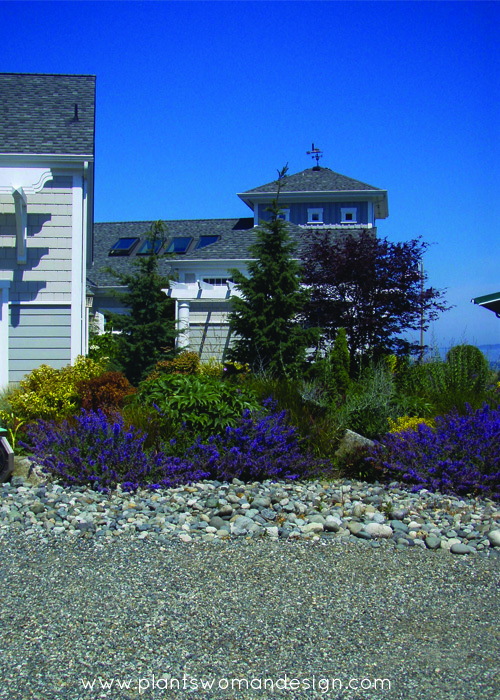
If a large house sits on a small lot (as is often the case now days) it is good to use taller thin trees and sweeps of the same types of plants to make it feel more grounded. The role of the landscape is to help the house blend in with the land around it.
Once scale is established planning what plants and hardscape to use is easier to determine. Think big, cozy, nestled, blended, integrated. These are all good descriptive words to get your brain thinking scale. Here are a few more ideas on how to incorporate appropriate scale…
Here is a bed along side a new outdoor seating area.
And again awhile later when the plants have grown in and matured.
Large trees with good scale on pathway between.
Large border in scale with large lawn and trees.
large house thin strip of pathway is in scale with house, airy taller plantings ground the house.
Taller trees in the background, smaller trees towards the house integrates trees and creates courtyard
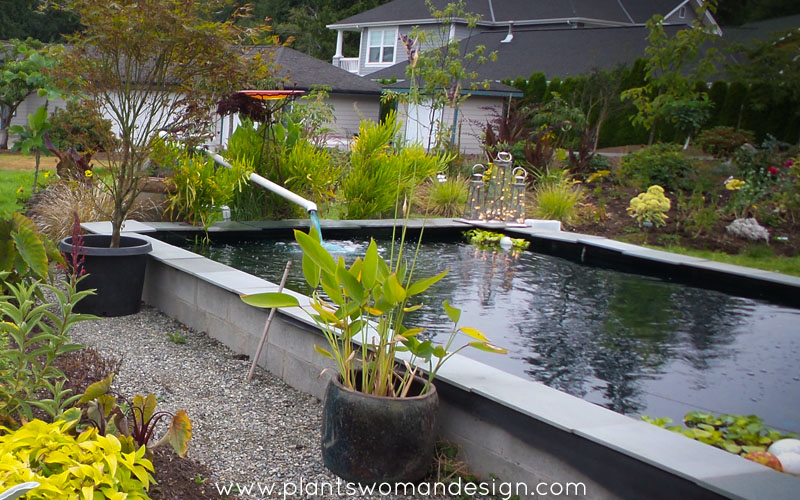
by Susan | Jul 24, 2015 | LB Tutorial: Design Challenge
Gardening is not a static thing but always evolving and changing. Sometimes aspects of the garden present themselves as challenges when least expected. Often planning and planting go hand in hand but situations change and the plan needs to be improved upon.
My Koi Pond is one of those.
The urgency to build the pond and get the Koi moved dictated a position out of the way of possible remodel (planning for the future). It also needed to be close to the house because the Koi are actually pets that need to be related to, fed and even touched. They would not like to be tucked into an out of way place (relational site location). They must also be protected from predators so close monitoring is also essential (practical site location).
One thing that has become important is the need for controlling the algae in the pond. The sun is intense in this open location so the water temperature is warm and the algae love the light and the warm water. There are several ways to handle the algae problem in any pond such as bacterial filters (called bead filters), UV light treatments, and chemical treatments. However, one of the easiest and most effective is shade. By shading the water the light is blocked and water is cooler thus helping to control the growth of algae. The bead filter, UV Filter and chemical treatments are in use but right now the pond is still the color of pea soup and suspended algae is obscuring the fish!
My recent visit to the new garden of Little and Lewis on Bainbridge Island confirmed that shade was probably best solution. They have a small pond with fragrant water lily and pitcher plants (get Botanical name) located in the courtyard with overhanging bamboo, Tasmanian Tree Fern and Abutilon. Crazy non – natives that required protection and a heater in the pond but that also create shade that keeps algae at bay.
The challenge now is how to create lush shade near the Koi Pond without blocking the view to the water. Granted there is a certain aesthetic that can be used in creating the necessary shade and also shaping a more focused view instead of wide-open view. The same principal is seen in tree pruning called ‘limbing up’ in which the gardener trims off lower branches so the focal point is cast between the tree trunks. This gives you a more interesting view by framing it and focusing the eye towards it.
Plantings at the end of the pond will help eventually but will take a while to grow into the actual shade needed to be effective. Here is a first photo of a Japanese maple in position towards the southeast.
This is located in front of the view so it will block some view, and provide shade from the morning sun.
I would love to hear the thoughts of other Gardeners out there. Share your ideas and insights on the Challenge. Here is a layout of the space. Let me know what you think!!
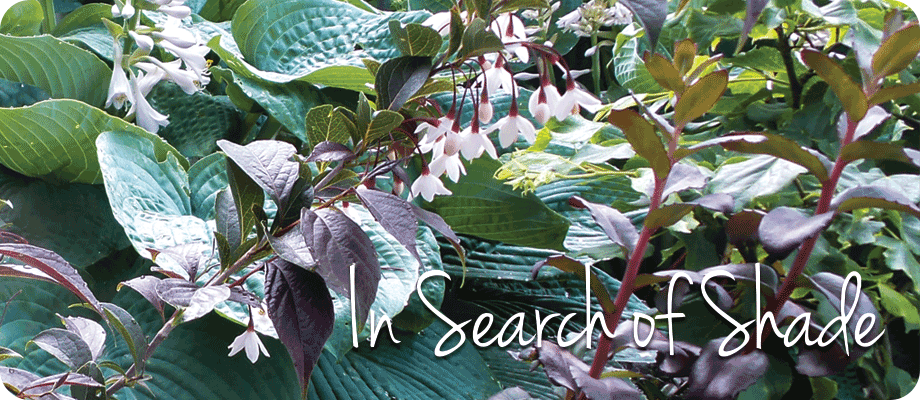
by Susan | Jun 12, 2015 | LB Tutorial: Design Challenge
Not surprising I suppose, most people in Washington State don’t have to worry about too much sun. Most lots are shady with many native trees which usually provides a place with enough shade to have a shade garden. As Robert Jones recently said ‘Shade plants are the more interesting plants’. I love shade plants but on my little piece of earth there is a lot of sun. Most of the property receives full sun all day except by the upper pond. That area receives the hot afternoon sun. Many good shade plants cannot take that type of exposure. The wonderful ariseamas, trilliums, hellebores, epimediums, paris, michela, camillia, solomans seal… You get what I mean, these cool shade plants will not be happy there.
The solution? Plant trees!
This means I actually get to plant some wonderful trees I’ve wanted to grow including some trees of my plant sale adventures like the Magnolia Wilsonii, Magnolia laevifolia, and Aesculus Hisp. ‘laciniata’. Of course there are some trees that have been removed from other gardens that were not good enough after delivery or just weirdly shaped that also get a place in my garden. There is a Japanese maple that was delivered from a grower that looked so bad I couldn’t put it in a client’s garden. I’ve had it for a while and it still doesn’t look good. In it went anyway. A black tulip magnolia with ½ a root ball, I’m not sure will make it. A dogwood that refused to bloom at a customer’s that I replaced with a more prolific bloomer. A red horse Chestnut that I purchased but never had a place for before, and a new cultivar of Cornus called ‘mandarin Jewel’ with orange fruit in the fall.
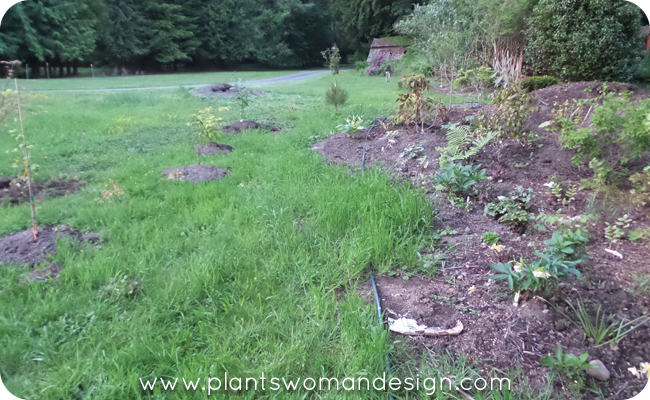
“before” – plant storage area
Now for the plan: I have been placing plants along the edge of the pond in partial shade since I moved in. Plants I saved from my old house and new things I’ve collected. The edge of the pond has gravel around it with lots of black plastic. To create the bed I removed the gravel and black plastic. Then, mixing new soil and compost together, I built up the bed and planted.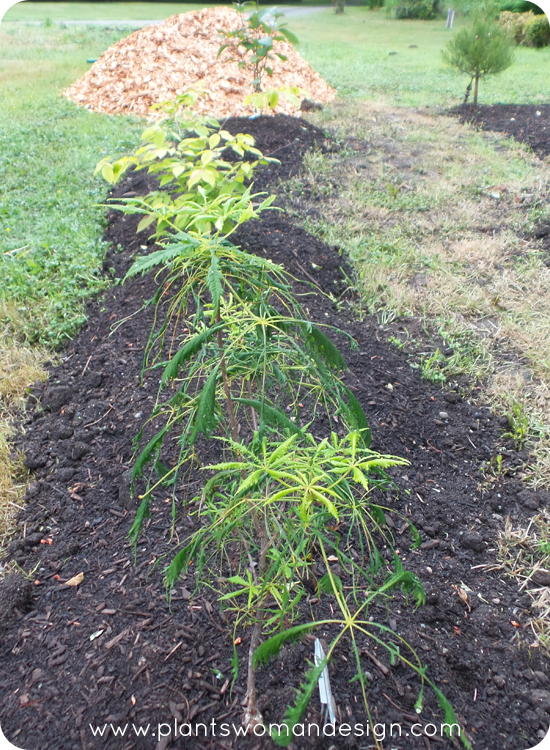 I want the trees to provide shade but I also needed to create a place to walk next to the shade plants. Placing the trees close together would obliterate the view of the plants so I placed them about 20 – 25 feet away from the shade plants. This will be a path after removing the grass there and putting down a good layer of wood chips. I hope to contact a wood-cutter to give me some of the chips left over from clean up.
I want the trees to provide shade but I also needed to create a place to walk next to the shade plants. Placing the trees close together would obliterate the view of the plants so I placed them about 20 – 25 feet away from the shade plants. This will be a path after removing the grass there and putting down a good layer of wood chips. I hope to contact a wood-cutter to give me some of the chips left over from clean up.
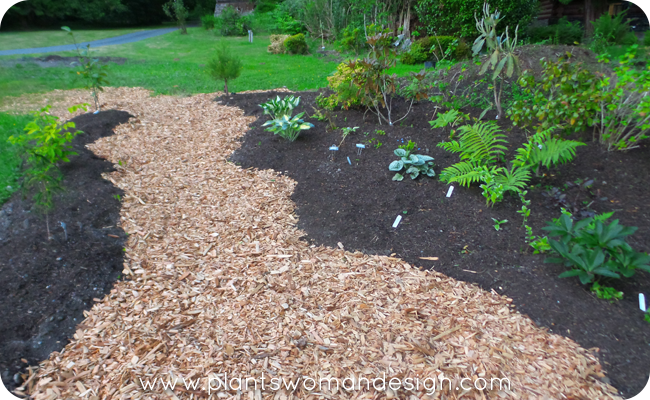
“after” – fully planted bed with walk
Cedar Play chips is the best material to use for the pathway. You can use other types of chips but the flat play chips make a good walking surface. The garden beds were weeded before the compost when down and the play chips in the center.
You can now see the pathway better and the indent of the beds. I’ll keep you posted as it grows in.

by Susan | May 22, 2015 | garden food, LB Tutorial: Design Challenge
There are times when I wonder if other designers get to design and plant vegetable gardens. I feel lucky that way! Recently I got to design and plant a veg garden for clients who only come in during the summer.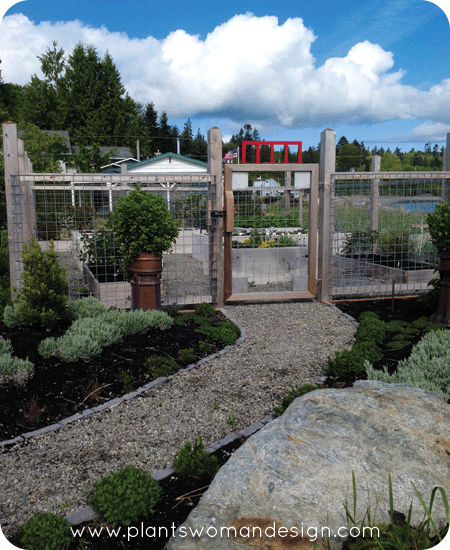 Obviously without year round residents a fence is needed. Because we aren’t sure how many deer are in the area the whole of the edibles and roses are protected. The fencing is galvanized wire and is connected to 8 x 8 cedar posts, the metal work on the gate was created by the owner. They put the fencing and gate together as a weekend DIY project.
Obviously without year round residents a fence is needed. Because we aren’t sure how many deer are in the area the whole of the edibles and roses are protected. The fencing is galvanized wire and is connected to 8 x 8 cedar posts, the metal work on the gate was created by the owner. They put the fencing and gate together as a weekend DIY project.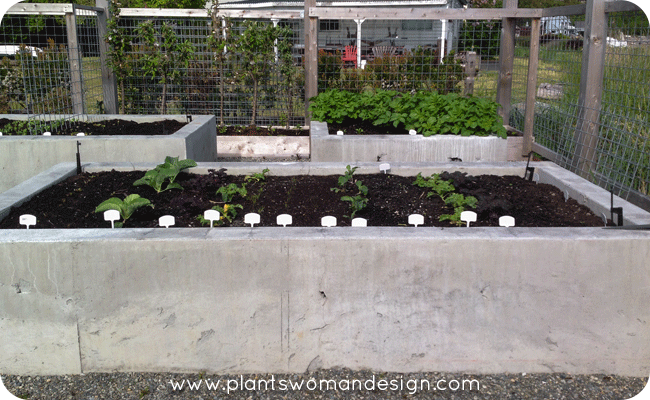 The raised beds are concrete poured into forms but not packed down to give it a rustic finish. We left the with bottom of the form open for good drainage and installed landscape fabric membrane over the native soil at the bottom of the beds to keep the beach grass out. Water is able to go through the soil and into the native soil beneath.
The raised beds are concrete poured into forms but not packed down to give it a rustic finish. We left the with bottom of the form open for good drainage and installed landscape fabric membrane over the native soil at the bottom of the beds to keep the beach grass out. Water is able to go through the soil and into the native soil beneath.
Drip irrigation was added with spray emitters at the corners and along the edge for good coverage. This system connected to the main irrigation system but is on a separate zone. We added a frost free hydrant for extra water when needed.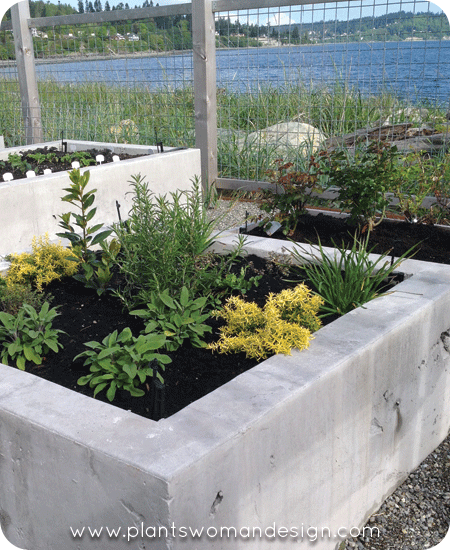 The first bed is the herb bed with a center cone of rosemary and a bay tree. Basil will be added later when it gets warmer.
The first bed is the herb bed with a center cone of rosemary and a bay tree. Basil will be added later when it gets warmer.
Early spring crops were put in first with some starts of kale and broccoli added along with the seeds of the same. I used different colors of kale and chard along with several colors of lettuce to make patterns in the planting. Red leafed lettuces, Radicchio, Romaine lettuce, spinach, and arugula are all planted in rows to make a pattern.
Fun purple beans, purple sprouting broccoli and watermelon radishes add some interest and more color. One bed is dedicated to exuberant potatoes both fingerling and yukon gold. Chard is tucked in there for fall color. We dig the potatoes out in the spring removing some. Here in the Pacific Northwest potaties continue to grow all year so will get too congested if left on their own.
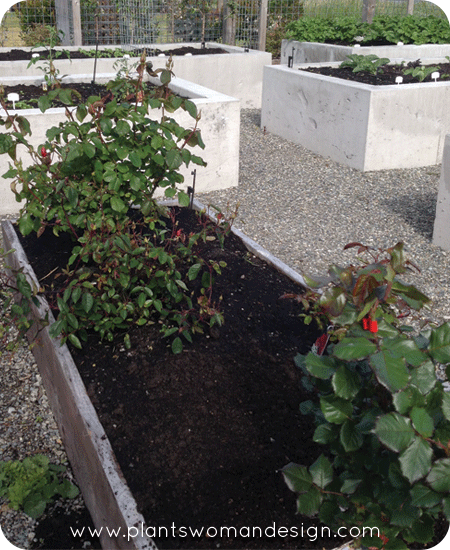 Two side beds hold a collection of roses for cutting. Two new ones we are trying this year are Chihuly and Anna’s Promise.
Two side beds hold a collection of roses for cutting. Two new ones we are trying this year are Chihuly and Anna’s Promise.
How many of you readers grow a vegetable garden along with the decorative ornamentals? Tell me what your favorite vegetables or herbs are!



